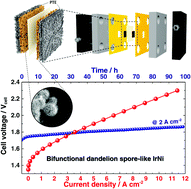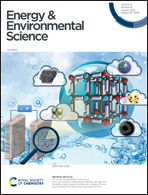A highly active and stable 3D dandelion spore-structured self-supporting Ir-based electrocatalyst for proton exchange membrane water electrolysis fabricated using structural reconstruction†
Abstract
Proton exchange membrane water electrolysis (PEMWE), the most energy-efficient low-temperature electrolysis method, is promising for converting intermittent renewable energies into stable hydrogen chemical energy. However, the cumulative corrosive environment resulting from the acidic conditions required and the positive half-cell potentials imply that only materials having high intrinsic activity and stability can be used. Herein, we propose catalysts and a corresponding fabrication method that meets these requirements. A 3D dandelion spore-structured self-supporting IrNi electrocatalyst is directly fabricated on a porous transport layer through the adsorbed H-induced co-electrodeposition of a core–shell IrNi–Ir structure. Subsequent dealloying generates a highly porous nanostructured Ir-based framework robust to the oxygen evolution reaction (OER) and hydrogen evolution reaction (HER) in a wide pH range. Specifically, it exhibited overpotentials of 248 mV (OER) and 15 mV (HER) at ±10 mA cm−2 in an acidic electrolyte with exceptional stability even after constant operation at 200 mA cm−2 for 50 h (OER) or 5000 potential cycles (HER). When used as a bifunctional catalyst (0.67 mg cm−2) for PEMWE, 6.5 A cm−2 was obtained at a cell voltage of 2.0 V. The degradation rate was only 1.58 mV h−1 under extremely harsh test conditions of 2 A cm−2 for 100 h, thus verifying the exceptional stability of a single cell. This is the first report of bifunctional catalysts with such high performance and stability fabricated using a simple method, and this work can aid the commercialization of PEMWE.



 Please wait while we load your content...
Please wait while we load your content...